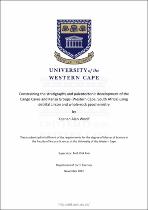| dc.contributor.advisor | Frei, Dirk | |
| dc.contributor.author | Woolf, Keanan Alan | |
| dc.date.accessioned | 2023-07-13T11:06:08Z | |
| dc.date.available | 2023-07-13T11:06:08Z | |
| dc.date.issued | 2022 | |
| dc.identifier.uri | http://hdl.handle.net/11394/10387 | |
| dc.description | >Magister Scientiae - MSc | en_US |
| dc.description.abstract | The Saldania Belt is a Neoproterozoic to early Paleozoic low-grade orogenic belt that borders the southern and southwestern margins of the Kalahari Carton. It forms part of the Neoproterozoic Pan-African and Brasiliano tectonic belts in southern Africa and southeastern South America, related to the assembly of southwestern Gondwana. The Saldania Belt is composed of several inliers, one of which is the Kango Inlier. The Kango Inlier is an east-west orientated foreland basin consisting of several groups and formations. The Cango Caves Group forms the basal unit within the Kango Inlier, comprising of the Matjies River, Groenefontein and Huis Rivier formations. Using a combined study incorporating petrographic, geochemical, isotopic and U-Pb geochronological data, the Cango Caves Group is investigated to aid in deciphering the crustal evolution of the Kango Inlier. | en_US |
| dc.language.iso | en | en_US |
| dc.publisher | University of the Western Cape | en_US |
| dc.subject | Basin evolution | en_US |
| dc.subject | Cango Caves Group | en_US |
| dc.subject | Geochronology | en_US |
| dc.subject | Groenefontein Formation | en_US |
| dc.subject | Huis Rivier Formation | en_US |
| dc.title | Constraining the stratigraphy and paleotectonic development of the Cango Caves and Kansa Groups (Western Cape, South Africa) using detrital zircon and whole-rock geochemistry | en_US |
| dc.rights.holder | University of the Western Cape | en_US |

